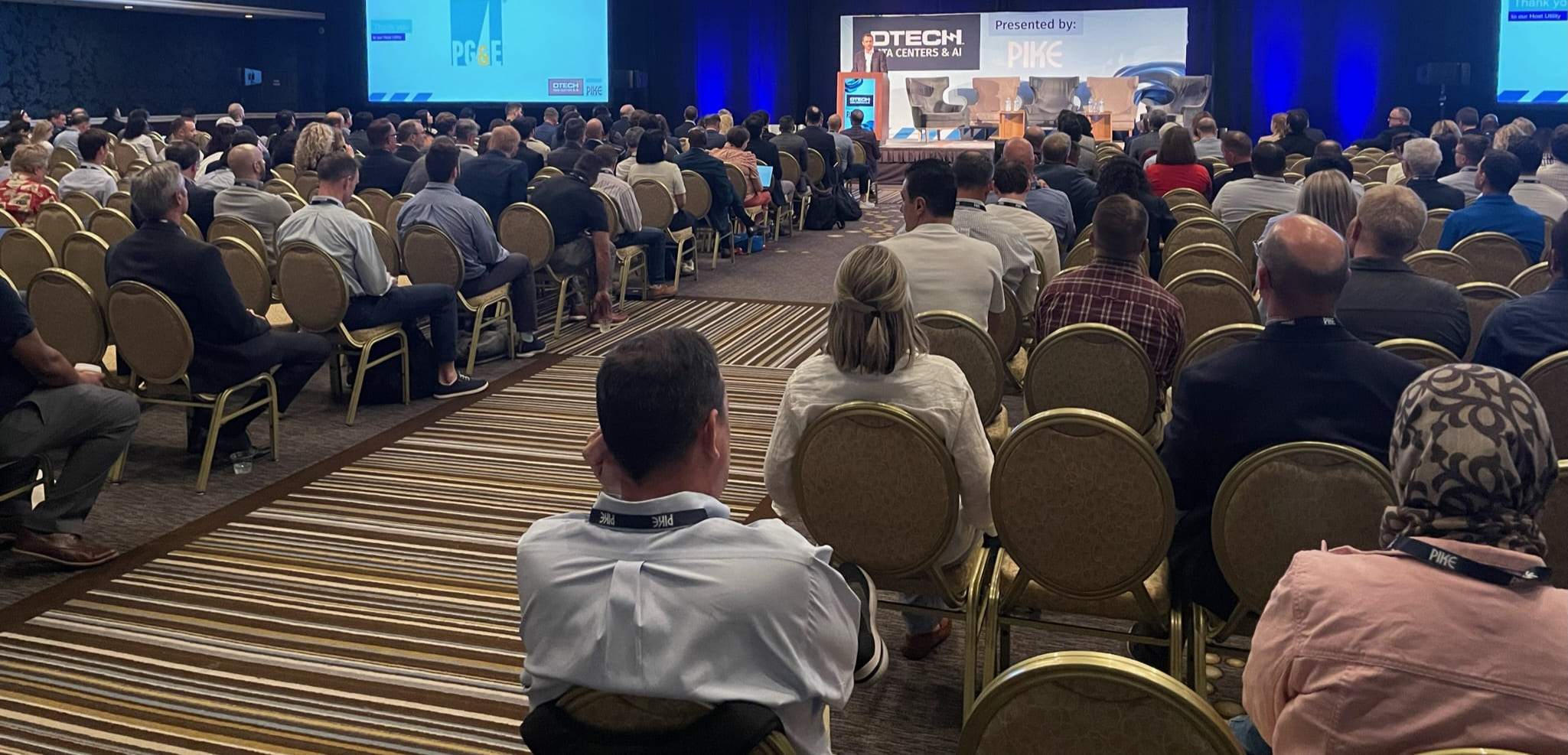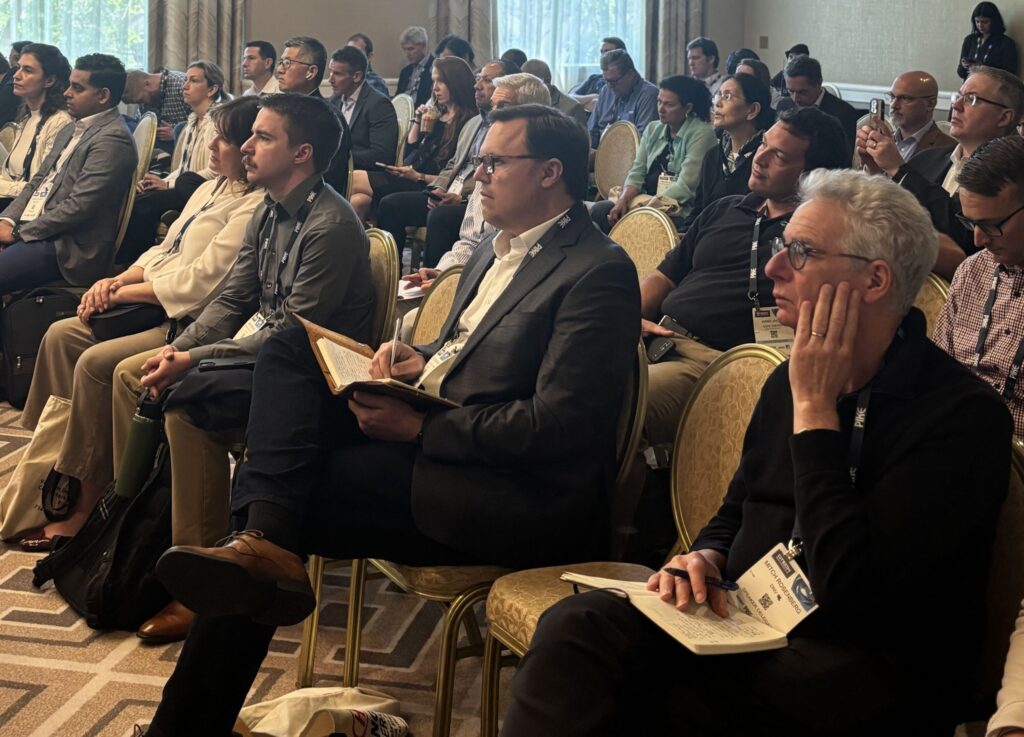
Bridging the Gap: Aligning Developers and Utilities at the 2025 DTECH Data Centers & AI Conference
The 2025 DTECH: Data Centers & AI Conference (DTECH) brought together utilities, developers, and infrastructure professionals to discuss a salient and pressing challenge: how to plan for and provide scalable energy solutions to meet exploding electricity demand at data centers. Hosted by Pike Corporation and PG&E, the event focused on bridging the gaps between data center developers and utilities, highlighting both friction points and opportunities for greater collaboration.

NEEDS AND CHALLENGES
Developers of colocation, enterprise, and hyperscale data centers all highlighted energy access as their number one priority when siting new facilities. But access to electricity alone is not enough – developers also desire reliability and the ability to scale in the future. And if that wasn’t challenging enough, they also want power today, not after the decade it would take for a utility to build a new transmission line.
Overall, developers search for an electricity source that is:
- Available immediately
- Scalable for the future
- High quality (reliable and low latency)
In addition to power considerations, developers may also look to site data centers near fiber optic infrastructure and population centers.
Utilities receiving interconnection requests from developers develop lengthy interconnection queues, leading to a median length of 5 years from connection request to commercial operation for projects in the US in 2023. With a duty to serve, utilities must seriously consider each request and determine how they could meet the needs of each new customer. Their overall mission is to serve all customers reliably while managing risk and long-term infrastructure investments. Utility priorities include:
- Maintaining power reliability for existing customers, especially as both renewable energy generation and peak demand grows
- Accurately forecasting demand and required investments, to avoid overbuilding grid infrastructure (which can lead to stranded assets) or an inability to meet peak demand (which causes grid instability)
DTECH surfaced several common challenges for data centers and utilities:
1. Communication Gaps
There’s often a lack of transparent, two-way communication between developers and utilities, especially during the planning stage of new data center developments. Developers may not have firm demand forecasts, and often approach utilities with the question of “what capacity is available?” However, utilities want to work in reverse and prefer to receive a specific request that they can study. Even when developers are specific, they frequently overstate their immediate power needs, presumably to allow for growth and err on the side of excess capacity, and sometimes never reach the capacity they initially requested.
2. Uncertain Demand Forecasts
Developers frequently “shop around,” submitting interconnection requests to multiple utilities to keep their options open for the most compelling response. This clogs interconnection queues with speculative or “ghost” projects, distorting demand forecasts and delaying timelines. But it’s difficult to distinguish which projects are real and which are unlikely to materialize.
3. Limited Tools to Unlock New Capacity Quickly
Traditionally, adding grid capacity has almost always meant building new power plants and transmission infrastructure, which is costly and slow, with new transmission line construction taking 10 years or more. With reliability such a high priority, many utilities are hesitant to commit to newer or more innovative generation sources or put too much trust into “non-wires alternatives.” High-load interconnections are already complex and difficult to simulate, so utilities are understandably cautious to introduce technologies with the potential to further destabilize the grid.

MODERN PLANNING APPROACHES
DTECH speakers and attendees discussed several promising strategies that could improve the planning process for both developers and utilities:
1. Proactive Planning and Collaboration
By engaging all stakeholders – utilities, developers, regulators, and local communities – early in the planning process, participants can streamline approvals and accelerate timelines. Open, early communication enables faster alignment, clearer expectations, and quicker decisions. Utilities can take a more active role by proactively identifying and designating sites that are suitable for data center development and finding ways to accelerate project preapproval or disqualification. Conference speakers noted that when it came to decision-making, getting to a faster ‘no’ was just as helpful as getting to a faster ‘yes.’ Developers can use NDAs to facilitate open dialogue and more comfortably share expectations.
2. Updated Approaches to Grid Planning
Traditional utility resource planning calls for generation assets and infrastructure that can meet peak demand across all 8,760 hours of the year. But this means building infrastructure that is unneeded for most of the year. In a conversation on resource adequacy, panelists discussed whether this model was outdated and called for utilities to consider more flexible models that reflect actual usage patterns and dynamic grid capabilities. For example, deploying large-scale battery energy storage to cover peak loads could avoid the construction of additional generation infrastructure.
3. Creative Interconnection Requirements and Incentive Structures
As demand for interconnection grows, traditional resource planning models are struggling to keep up. A more creative approach to interconnection requirements and incentives could reward adaptability and better align with grid needs. One strategy that Arizona Public Service deployed involves specifying discrete time windows to cluster new interconnection requests, which helps the utility plan for all requests at once and prioritize viable projects. Utilities can also offer developers clear incentives or trade-offs, such as exchanging capacity or speed for greater flexibility.
If utilities are worried about developers overestimating their demand, they could also specify consumption minimums or require long-term commitments. Multiple utility representatives described agreements where developers covered upfront infrastructure costs but were given energy rebates as their load materialized. This aligns financial risk with actual demand and encourages more thoughtful, phased development. Finally, to support grid stability, interconnection agreements can also include performance requirements like load smoothing and ramp rate compliance to ensure that new loads integrate smoothly without destabilizing the system.
EMERGING TECHNOLOGIES
A handful of technologies were talked about repeatedly across panels to support the strategies outlined above. The top technologies that attendees were excited about included:
1. Microgrids and Distributed Energy Resources (DERs)
Data center developers that don’t want to wait years for grid interconnection are increasingly exploring microgrids and DERs to provide their own power. However, total grid independence can lead to higher costs, reduced flexibility, and greater complexity. Because of this, these energy sources are often used as “bridge power:” powering data centers independently at first, then transitioning to a backup role once the facility is fully connected to the grid. Bridge solutions are typically hybrid energy systems that combine solar, wind, natural gas, and even nuclear power.
2. Battery Energy Storage
Battery energy storage systems are essential in a new energy ecosystem where flexible infrastructure becomes critical. Battery systems facilitate the use of renewable energy sources like solar and wind by smoothing out supply. Large battery storage systems can provide numerous benefits for both developers and utilities, including load smoothing, peak shaving, and short-term backup power in the event of an emergency shutoff. Batteries can enable data centers to effectively participate in demand response programs and reduce energy use during peak periods, which can help the facility better align with grid needs and reduce operational costs.
3. Nuclear Power
A few references were made to recent large-scale nuclear agreements intended to power new hyperscale data centers. However, excitement was much more palpable when attendees discussed small modular reactors (SMRs). SMRs were frequently – and sometimes wistfully – referenced as a promising technology for the future of clean energy. The head of business development at Oklo, a nuclear fission technology provider and recycler, closed the conference with a compelling pitch for a nuclear future, comparing current nuclear energy regulation in America to “a 5 mile-per-hour speed limit on the 101.”
LOOKING AHEAD: INTEGRATING EFFICIENCY INTO THE CONVERSATION
One notable topic that was missing from the conversation at DTECH was data center energy efficiency. This omission felt like a missed opportunity for meaningful dialogue, as efficient data center design and operation can meaningfully reduce electricity and water consumption. As the industry continues to grow, it would benefit future conferences to acknowledge energy efficiency to reflect the full spectrum of challenges and innovations shaping the data center industry. We will be addressing data center energy efficiency opportunities in more detail in a future blog post.
Overall, the DTECH conference made one thing clear: the future of data and AI is inextricably linked to the future of energy. By fostering open dialogue, embracing innovation, and aligning incentives, developers and utilities can co-create a resilient, intelligent, and sustainable digital infrastructure.
Interested in data centers and energy efficiency? 2050 Partners supports utilities, government agencies, national laboratories, and research organizations navigate these challenges. Contact us today to learn more or schedule a conversation.
We look forward to seeing you at DTECH: Data Centers & AI in 2026!


